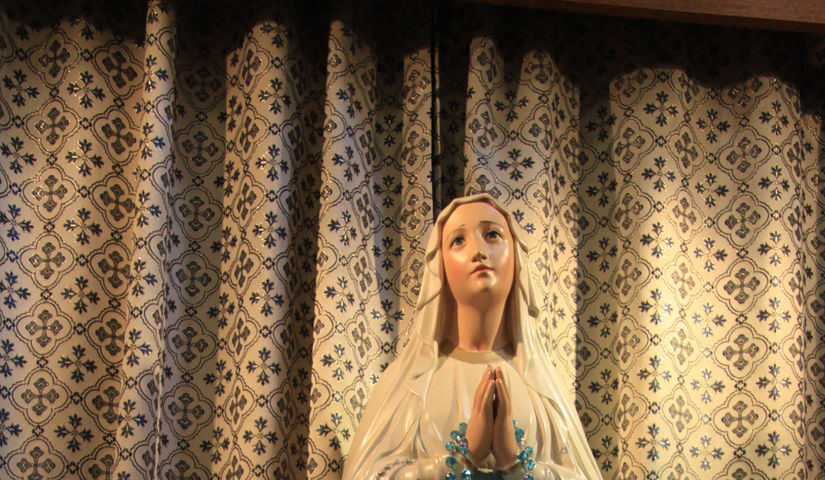
Pilgrimage to Wells 2018
Annual 40 Hours of Adoration 2018
Uxbridge has now been swallowed up by Greater London but it was originally an important market town in west Middlesex, situated on the London-Oxford road. Its first church, dedicated to St Margaret of Antioch and still standing in the town centre, dates from at least the thirteenth century.
Martyrs and Hiding Holes
Following the Reformation, some Catholics secretly practised their Faith in the area. In October 1580, for example, St Edmund Campion, Fr Robert Persons and other Jesuits working in England met at William Griffiths’ house (‘Southlands’), near Uxbridge, to discuss the mission. One result of this ‘Uxbridge Conference’ was the writing of Campion’s celebrated Rationes Decem (Ten Reasons), aimed at non-Catholics, and the establishment of several clandestine printing presses to produce apologetical works.
Another notable Catholic centre was ‘Moorcrofts’, a name still found locally. The house that once stood there belonged to the Catesby family, one of whom was a conspirator in the Gunpowder Plot, and was briefly used as the headquarters of Fr Henry Garnet, the Jesuit superior in England. After the dramatic escape of the Jesuit priest, John Gerard, from the Tower of London on 4 October 1597, he rode to Uxbridge with St Nicholas Owen, a lay brother who specialised in making hiding holes for priests. They had dinner with Fr Garnet at Uxbridge and, as Fr Gerard later recalled, ‘the rejoicing was great. We all thanked God that I had escaped from the hands of my enemies in the name of the Lord’.
In March 1598 the Jesuit Oswald Tesimond arrived in England with Ralph Ashley and visited Moorcrofts where ‘we were received with the warmest welcome and the greatest charity imaginable'. Several days after word arrived from London that ‘the Privy Council had had notice of that house and that without doubt the Queen’s officers would come to search it that very night’. Tesimond was impressed by Garnet’s great calm, proving himself ‘to be an old soldier and experienced captain, accustomed to such assaults’. Garnet ‘gave orders to hide in the hiding-places which had long since been prepared for such an occurrence, everything that could show that the house belonged to Catholics: as books, altar vestments, pictures and everything of the sort; and then stowed away all things of greater value’.
Jesuits were also active in the Buckinghamshire village of Denham, just outside Uxbridge, in the mid-1580s. Under the leadership of Fr William Weston, a group of priests (including the martyr Blessed John Cornelius) celebrated a number of public exorcisms to prove to the people the power of the Catholic Faith. Denham was the epicentre of this rather unusual form of evangelisation, but another location was the house in Uxbridge of a certain ‘Hughes’. The exorcisms, which were sensationally reported in a book by the anti-Catholic Samuel Harsnett, inspired Shakespeare for a scene in King Lear.
A New Church
The mission grew from strength to strength and by 1907 the congregation numbered 150, with school attendance at 60. In time plans were made for a larger, more permanent church. This was the brainchild of Fr Thomas Moloney, who bought the current presbytery and acquired the land that stood at the back so that a church could be built. The foundation stone was eventually laid on Low Sunday 1931 by Archbishop Alban Goodier, an English Jesuit who had been Archbishop of Bombay between 1919 and 1926. The new church was designed by the diocesan architect, T. H. B. Scott, whose other churches included those at Cricklewood, Hendon, Muswell Hill, Parsons Green and Shoeburyness. It was built of brick in the Romanesque style, seating 350. The church was built quickly and opened by Cardinal Bourne on 29th September 1931.
Churches can only be consecrated once the debt is cleared and this typically took decades. It is a testament to Fr Moloney’s administrative ability that Our Lady of Lourdes and St Michael was ready to be consecrated on 14 May 1936, less than five years after its opening. The ceremony was performed by Bishop Patrick Casey of Ross, a seminary classmate of Fr Moloney, and the ritual took three hours and forty minutes.
The building of the church was made possible, in part, by the generosity of the Gilbey family of Denham. The Gilbeys were well known wine merchants and (from 1872) distillers of gin. William Crosbie Gilbey and his wife Margarita (from the gin family of Gordon) are memorialised in a plaque near the Lady Altar and a number of Gilbeys were baptised at Our Lady of Lourdes and St Michael.
Into Modern Times
Well-known faces from the silver screen could be sometimes spotted in the congregation in the mid twentieth century, including Finlay Jefferson Currie (who played Abel Magwitch in David Lean’s Great Expectations and St Peter in Quo Vadis), Noel Purcell (The Blue Lagoon) and Mary Morris (The Thief of Baghdad, Pimpernel Smith).
Town development in the 1960s and 70s radically altered the neighbourhood of the church. Built originally on a quiet residential street, it now became isolated from the town by the Pavilions shopping centre. However, its presence amidst the newer commercial buildings and beside a busy dual carriageway is eloquent testimony to the place of the Church in the heart of the world. In recent years the congregation has become highly multi-cultural and diverse, with a Sunday Mass attendance of around 800, a third of whom are children.







